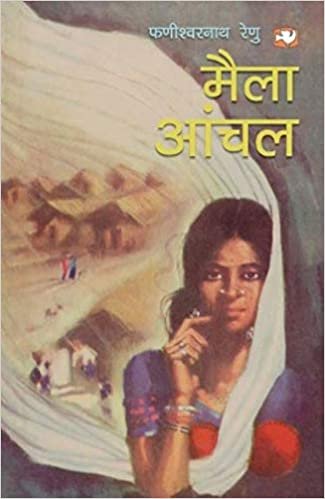Maila Aanchal

Rating: 4.4/5
Author: Phanishwar Nath Renu
Publisher: Rajkamal Publication
Publishing Date: 1954 (originally published), 2008 (Rajkamal)
Language: Hindi
Genre: Classic Fiction
ISBN-10: 8126704802
ISBN-13: 978-8126704804
Format: Paperback, Hardcover, Kindle Edition
Pages: 353 (paperback)
Cost: Rs. 300 (Paperback), Rs. 675 (Hardcover), Rs. 139.93 (Kindle edition)
Plot:
This social Novel details the trials and tribulations of a small group of people in a remote village of North-east Bihar during the Quit India Movement. A short plot summary of this book reads as:
Tehsildaar babu, by the virtue of his position in local administration, has acquired large tracts of land and turned into a Zamindaar (landlord) himself. His daughter Kamla suffers from some disease that results in fits. Doctor babu (Dagdar babu) has left his city-life to work in these hinterlands. This is the realm where Malaria, Kalazar and numerous such epidemics run havoc, where people trust tantriks and pandits (witches and priests) more than they trust the science of medicine. Here, ‘Poverty’ itself is the biggest disease affecting people, and besides the lack of basic amenities, people lack education and faith in government as well as in the doctor. The doctor babu makes a special effort to fight disease as well as a lack of belief in medicine. He battles both the ailments and the superstitions of the people around him. Kamla, who is one of his patients, perhaps the only rich patient, falls in love with him. Lakshmi lives at a Matth (a kind of monastery) and serves an old priest and they have a scandalous relationship. The Priest has a servant, who bears all the insults from his master. He is skilled at playing the Khanjira (a musical instrument).
This novel mainly depicts the contemporary social life of the people who are poor and backward. It is considered to be one of the finest novels ever written in Hindi literature.
Review:
‘Maila Anchal’ is a regional novel in a true sense as its local colour is reflected by means of dialect, lifestyle, superstitions and beliefs, festivals, and culture of the rural people. It depicts the landscape of Bihar, the division of society on the basis of caste, Indian struggle of independence, and the true face of rural India. It has introduced a new form, by fundamentally changing the structure and narrative style of Hindi novels.
The characters are fit the region and they are guided by the local characteristics. The region becomes to be a living character and plays a great role in leading the characters to the development of the story finally to the conclusion. The character of Doctor Babu is based on the life-story of Dr. Alakh Niranjan, who was alive (and 100 years old) in 2003.
The author has said himself that this is a zonal novel. ‘Zoroastrianism’ refers to the abundance of words and traditions of a region in a novel. In this novel, many words used in Mithila region will be found. There’s a tradition followed by almost every village where they regionalise English names: this has been accurately portrayed in the novel.
While the author talks about social change and social issues closer to heart to reformists, he puts forward suggestions instead of using direct preaching. The reality of such issues is contemporary as well as global. Social evils like poverty and slavery, illiteracy and superstition, exploitation, and oppression are not new in human history and will not be so in the future even though efforts have been made to eliminate them. He also keeps the authenticity of the story and the setting intact by playing with local words and variations. At times, he seems to openly mock the flowery, orchestrated language often used.
'Maila Anchal' is regarded one of the greatest examples of "Anchalik Upanyas" (regional novel) in Hindi.
Milestones of the book:
Phaniswar Nath Renu was honoured with Padma Shri in 1970 for this (‘Maila Anchal’) work of literature.
About the author:
Phanishwar Nath Renu (4th March 1921- 11th April 1977) was a revolutionary novelist of the post-Premchand era of the Hindi literature. He was the voice of contemporary rural India and among the pioneers to bring regional voices into the mainstream Hindi literature.
He received his primary education in Araria and Forbesganj. He passed his Matriculation from Viratnagar Adarsh Vidyalaya(school), Viratnagar, Nepal, and Intermediate from Kashi Hindu Vishvavidyalay (university) in 1942. He actively participated in the Indian freedom struggle in 1942. He was even involved in the Nepali revolutionary struggle in 1950 against the dictatorship which led to the establishment of democracy in Nepal.
Phanishwar Nath Renu’s writings evoke an intimate feeling with the reader, which he developed by using the local flavour of the language instead of Khari Boli. A few of the novels written by him are Maila Anchal, Parti Parikatha, Juloos, Deerghtapa, Kitne Chaurahe and Paltu Babu Road. Among all his works ‘Maila Anchal’ (1954) is his masterpiece. He was honoured with Padma Shri by the Government of India for this novel. It has introduced a new form of the novel by radically changing the structure and narrative style of Hindi novels.















































